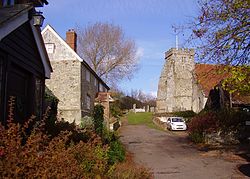Arreton
| Arreton | |
|---|---|
 Arreton Old Village |
|
| Arreton shown within the Isle of Wight | |
| Population | 988 (2011 Census including Blackwater , Downend , Horringford and Mereton) |
| OS grid reference | SZ545865 |
| Civil parish |
|
| Unitary authority | |
| Ceremonial county | |
| Region | |
| Country | England |
| Sovereign state | United Kingdom |
| Post town | NEWPORT |
| Postcode district | PO30 |
| Dialling code | 01983 |
| Police | Hampshire |
| Fire | Isle of Wight |
| Ambulance | Isle of Wight |
| EU Parliament | South East England |
| UK Parliament | |
Arreton is a village and civil parish in the central eastern part of the Isle of Wight, England. It is about 3 miles south east of Newport.
The settlement has had different names and different spellings over the years. For example, the village was called Adrintone in the 11th century, Arreton in the 12th century, Artone in the 13th century, Atherton and Adherton in the 14th century, Adderton in the 16th century, and Aireton in the 17th century.
The village has two inns with a long history. The White Lion Inn has been in business for two centuries, and was a staging inn on the A3056 road between Newport and Sandown. At one time, there was a Red Lion Inn nearby. The Arreton Barns Craft Village commercial complex contains a pub called "The Dairyman's Daughter", named after a best selling book about a girl (Elizabeth Wallbridge) from Arreton by Rev. Legh Richmond.
Arreton is home to the "Shipwreck Centre and Maritime Museum", which moved to the Arreton Barns Complex from Bembridge after 26 years. It is housed in a "Grade II stone barn" at Jacob's Yard in the Arreton Barns Centre. Visitors to the Shipwreck Centre can buy a variety of souvenirs and salvaged objects, including Copper ingots from a Victorian steamer ship which capsized off the coast nearby.
St. George's Church, Arreton is renowned. The war memorial was designed by local architect, Percy Stone (1856–1934). On the road to the church is the 17th century Stile Cottage which was previously used to store ales for the church.
Opposite the church is the Island Brass Rubbing Centre, Lavender Cottage (which sells lavender products) and a wood carving of St. George and the dragon by local sculptor Paul Sivell.
Arreton Manor, the local manor house, was rebuilt between 1595 and 1612 by Sir Humphrey Barnet. Arreton Manor is mentioned in the Domesday Book (1086) and has been owned by at least 8 monarchs, the earliest being King Alfred the Great who left it in his will to his youngest son Aethelweard.King Charles I reviewed troops on the lawn in 1629, and Queen Victoria planted a tree in the garden.
...
Wikipedia

